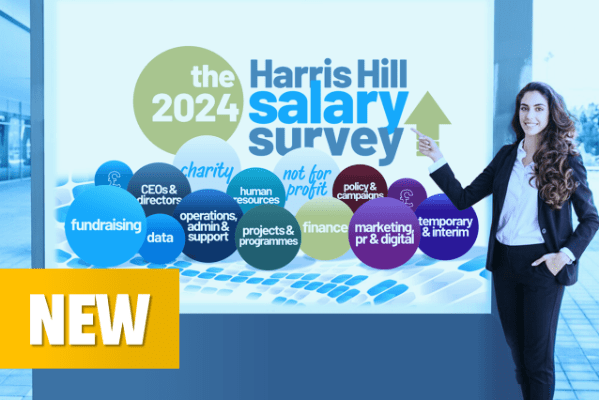Given that so many work with marginalised or disadvantaged groups of people, you’d expect charities to be more aware than most of the barriers to employment such groups often face, and the need to be more inclusive. Which research suggests that by and large, they are.
However research also suggests that in terms of using that awareness to build a more diverse workforce, they’re lagging behind sectors like hospitality, arts & entertainment and even telecoms, so fresh from National Inclusion Week, it seems a good time to look at the progress of inclusive recruitment in the charity sector: why it’s needed, what employers are doing, and how to apply it to your own recruitment process.

By our count, there are precisely two ways of making your organisation more diverse and inclusive: change the people you have, or change the people you hire.
The first means trying to eliminate unconscious bias through ongoing training, the impact of which some believe to be limited and fleeting at best. If for some reason you haven’t got vast sums to throw at a largely fruitless exercise, that leaves you the second option, putting it squarely in the purview of recruitment.

Why do we need inclusive recruitment?
According to disability charity Scope, around 23% of working age adults in the UK are disabled, while the British Dyslexia Association reports that more than 15% are neurodivergent, and numbers are rising.
While there’s overlap between the two groups, that’s still at least a quarter of the workforce facing obstacles to employment or progression, while many more still face an uphill battle (even if arguably on a slightly lesser incline than in the past) due to factors like race, age and gender.
For many people, breaking down those barriers is simply the right thing to do. One organisation determined to do so is South London’s Maudsley Charity, which became an independent entity (from the Maudsley Hospital) in 2018.
We’ve partnered with them to run inclusive recruitment processes since 2021 when, as Director of Finance and Operations Lisa Kiew explains: ‘We recognised that like many charities and the third sector as a whole, we didn’t reflect the communities that we work with and on behalf of. For that to change, we needed to commit, invest resources and prioritise taking action.’
The charity has pioneered a raft of inclusive initiatives, including a well-received webinar where prospective candidates can, swathed in the cloak of anonymity if preferred, ask anything they like of the Maudsley team. It’s a smart decision, because moral arguments aside, at a time when so many employers are struggling for candidates, it simply makes sense to keep the talent pool as large as possible by ensuring no-one is needlessly excluded.
What’s more, maximising the available talent isn’t the only benefit of being more inclusive. There’s now plenty of evidence that diverse teams outperform their more homogenous counterparts, while a diverse workforce also improves the employer brand, which in turn makes it easier to recruit. Call it a virtuous circle. It likes that.

What makes an inclusive recruitment process?
If you’re not using discriminatory language or actively precluding particular groups, it’s easy to believe that your hiring process is already inclusive and open to all. But that might not necessarily be the case, as there are potential pitfalls throughout the process that might be pushing certain groups away.
To address this, we suggest working carefully through the process from a candidate’s perspective, paying particular attention to these key elements.
• The job description
• The person specification
• Advertising
• Applications
• Interviews
Let’s take these one by one, and fair warning, you might want another coffee first, there’s quite a lot of this.

The job description
Most readers of job descriptions are looking to answer one question: is this something I can do? Having a disability or other condition makes that a bigger question, and what can be even more frustrating than a ‘no’ is when there's just not enough information given to answer it at all.
Vague assertions like ‘the role requires some travel’ may suffice for those with few concerns or commitments, but many will need to know more. To where? How often? For how long? By what means? People can judge for themselves if a role is within their capability, but they need full and specific details to do it.
That said, listing every last responsibility of the role can look daunting, even if half of them amount to little more than a moment’s work. Rolling minor tasks into ‘other duties as required’ is fine, provided they don’t require anything more of the individual than is covered elsewhere. This can help to keep the list looking manageable and (importantly) proportionate to the salary on offer.
So to make your job description inclusive, think clear, sufficiently detailed to assess the logistics, but not overwhelming. Which brings us to…

The person specification
This is a little trickier. How do you make a list of ‘essential’ attributes, the very point of which is to exclude certain people, more inclusive?
In three words: less is more. The shorter the list, the fewer reasons for someone to rule themselves out, so question every requirement, challenge assumptions (look to the recent Paralympic Games for evidence that attributes once thought essential might not be), and be ruthless in removing criteria that are anything short of absolutely life-or-death vital.
Also, in the sober words of the CIPD: ‘When advertising for existing roles, we recommend assessing the needs of the role as it stands today, rather than relying on previous adverts or specifications’.
Which is to say, don’t just bang out the same spec as last time, because that’s what they did then too, and probably the time before that, and this is how you end up with ads calling skills ‘essential’ that haven’t been relevant for 20 years.
But why not aim higher and ask for everything that would make up the perfect candidate? You’re not expecting to get it, but there’s no harm in asking, right?
Actually, there might be: there’s a widely-quoted finding, shared by the Harvard Business Review and former Facebook COO Sheryl Sandberg among others, that while men are happy with 60%, women feel they need to meet 100% of the specified criteria before they’ll apply for a role. Making 100% all but impossible would therefore see female candidates rule themselves out.
As it turns out, this was purely a guess by someone in a meeting at Hewlett-Packard, but the claim has probably persisted because it sounds potentially true. Actual research by the Behavioural Insights Team found a far smaller difference in reality, but the point remains that asking too much simply reduces the proportion of boxes that even the strongest candidates can tick, and this makes them (whatever their gender) less likely to apply. Stick to the skills that are needed and no more.

Advertising the job
Be aware that the language in your ad can suggest a degree of bias. Words like ‘competitive’ or ‘driven’ can give the impression you’re expecting to hire a man, which can often deter female applicants, while words like ‘supportive’ or ‘nurturing’ can suggest you’re seeking a woman, although interestingly this doesn’t deter male applicants in the same way.
Consider where to advertise, too. If you’re not getting sufficient diversity from the usual channels, try others; there are now plenty of job boards aimed specifically at one or more marginalised groups. In our experience, these may not guarantee more hires from said groups, but they do show you’re willing to invest in attracting them, with positive effects on the employer brand that can pay off further down the line.
Referrals can be helpful if they’re targeted towards underrepresented groups, but remember that if you’re simply asking staff to refer a friend, you’ll tend to get people who are fairly alike. Be wary too of prioritising 'cultural fit' which, when you look at it, is just a more acceptable way of saying that you're looking for ‘people like us’.
Showing the salary of the role is a must: some groups (you can probably guess which) are more comfortable and successful negotiating salaries than others, so leaving it open increases disparities. Further to the earlier point about detail, salary information is pretty essential for jobseekers to know if it’s a viable prospect worth pursuing, while many see a certain lack of respect in expecting candidates to jump through the hoops of application (terrible band) with no idea if it’s even worthwhile.
Finally, you can use the ad to make applicants of all kinds feel welcome and included, by proactively inviting them to discuss any reasonable adjustments needed upfront.

Applications
How should people apply for the role? CVs and supporting statements suit some just fine - they’re familiar and the internet is awash with tips on doing them well – but they might not be the right forum for everyone to shine. Why judge someone’s ability to create a well-presented written document if what you’re looking for is resilience and interpersonal skills?
Inclusive recruiting means hiring people for what they can do, not what they can’t, so switching CVs for something that plays to their people skills might be more illuminating in this instance.
In the interests of eliminating bias however, some charities advocate for a highly standardised application form, often anonymised by removing names, dates and other identifying details. Everyone’s asked the same questions, making it easy to compare answers, and if nobody knows whose they’re reading, decisions cannot be influenced by anything other than the substance of what they have said.
However, a plea on behalf of applicants everywhere: it’s either a form or a CV, but not both. Few things say ‘we have no respect for your time’ as clearly as insisting a CV be uploaded, then asking for all the same information again in a different format.

Interviews
This is where bias gets some of its best opportunities to creep into the process, thanks to the presence of multiple people and a fair amount of actual human interaction (a quick pause here for our introverts to finish shuddering).
However, charities like the British Heart Foundation (BHF) are fighting hard to keep bias out, recently launching an interactive interview-building tool that reads the job description and person specification, determines the required characteristics, and designs questions to help you assess them objectively. These become part of structured interviews, in which all candidates are asked the same things in the same order, with their answers scored against specific criteria agreed in advance.
As Maggie Morgan-Valentine, BHF’s head of equality, diversity and inclusion told Civil Society: ‘By designing structured interviews with robust evaluation criteria, we can reduce the influence of bias and find the best candidates based on objective requirements for success in each role’.

Another approach we’ve been using with Maudsley Charity that’s becoming more popular is to send questions to interviewees in advance. ‘But surely this is madness?!’, we hear you cry, and it’s certainly unconventional, but the reasoning is sound.
Providing questions ahead of time allows you to evaluate candidates based on their considered answers - often a fair reflection of their knowledge and outlook - rather than what they blurt out on the spot under interview pressure, which often isn’t. It’s particularly helpful for neurodivergent candidates who may struggle to think on their feet, reducing stress and anxiety, and enables more people to perform well at interview than would otherwise be the case.
After all, unless responding to unexpected questions on the spot will be part of their job, does it matter if they’re not particularly good at it? By springing questions on people unannounced, there’s a risk of rejecting someone who’d be great at the job in favour of someone who’s simply good at interviews.
There are drawbacks of course, one being that candidates’ answers could sound robotic and over-rehearsed, focusing more on remembering the words than what they’re actually saying. This could make it hard to get a sense of their character or build a rapport.
There’s also a risk they could seek help from others, copy from the web or ask an expert – how will you know their answers are their own?
A solution that charities are increasingly using is to provide interview questions just a short time, perhaps a maximum of two hours, in advance. This retains the benefit of easing candidate nerves while minimising (albeit not entirely eradicating) their opportunity to get help or over-rehearse.
An alternative is to provide some, but not all, of the questions ahead of time, which gives space for more spontaneous, off-the-cuff conversation. This can give you a better sense of their character and personality.

Whatever you choose, it’s important to ensure a level playing field, by running an interview process that works equally for all.
Often overlooked in this are the financial costs for candidates. If someone has to travel from elsewhere into London, for example, during peak hours for a 9am interview, perhaps in smart new clothing they’ve had to buy, it’s neither cheap, nor something they’ll be able to do too often. Could the logistics of your interview process be limiting access to only those with the funds to take part?
The answer that many charities have alighted on is to hold all interviews online, the pros and cons of which are perhaps for another time, except to note that while this may lose something in terms of personal rapport, in today’s workplace it’s arguably just as important to see how someone performs on a Teams call as how they perform in an uncomfortably hot box room in your office.

Ultimately, there’s no secret formula that brings down the barriers and unlocks a vast untapped source of wonderfully diverse professionals. More often than not, the art of inclusive recruiting is simply to avoid things that drive them away.
There’s also a limit to how far it can go. With a single position, you’ll inevitably reach a point where you have to exclude all but one person, however innovative the route there.
But for everyone to have a fair chance of being that person, they need a fair chance of making the shortlist, a level playing field all the way back, and to feel they’ll be just as valued, just as welcome to take part in the process as anyone else.
And that’s where inclusive recruitment practices can really make a difference.
Team Harris Hill

For more advice or any assistance you need with inclusive recruiting, please contact our specialist consultants on 020 7820 7300 or get in touch via info@harrishill.co.uk

| |
text
-

Opportunity for all
Find out how we’re working to deliver more diverse, equitable and inclusive recruitment…
-

Recruiting a charity CEO?
Our executive recruitment specialists have an exceptional record of successful CEO, chair, trustee and…
-

Charity sector salaries
Check out the market rate for your charity role in the latest Harris Hill Salary Survey.













